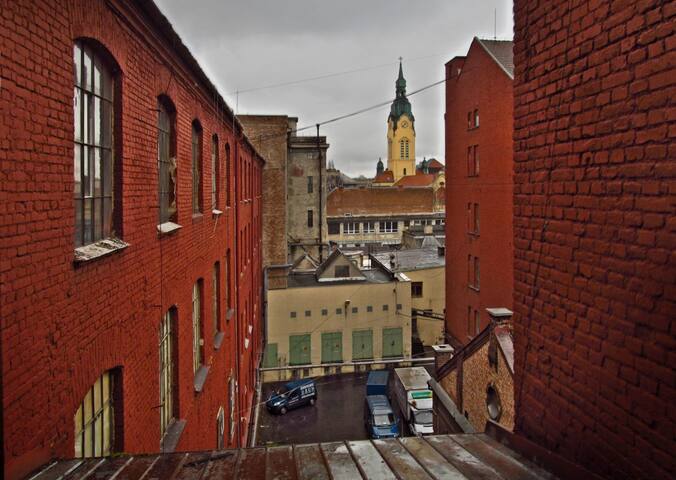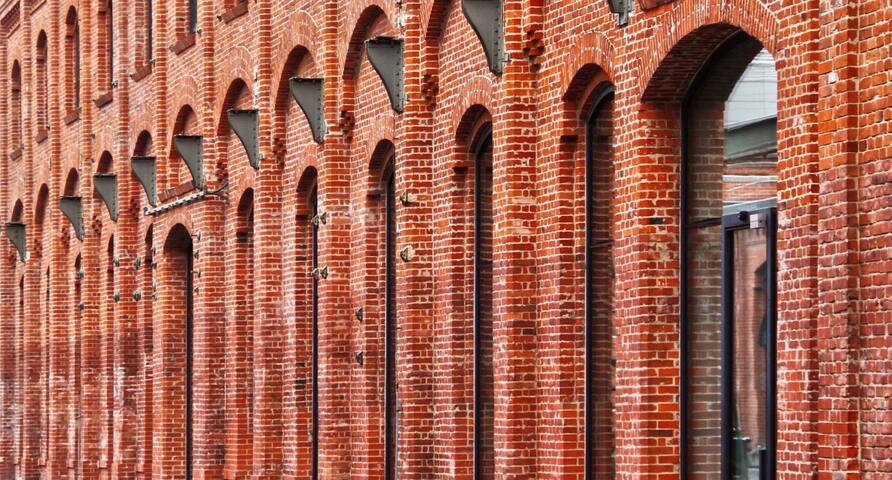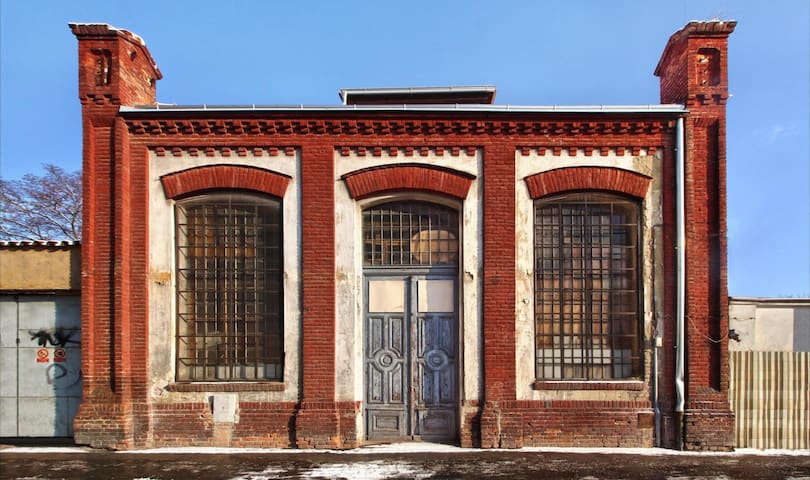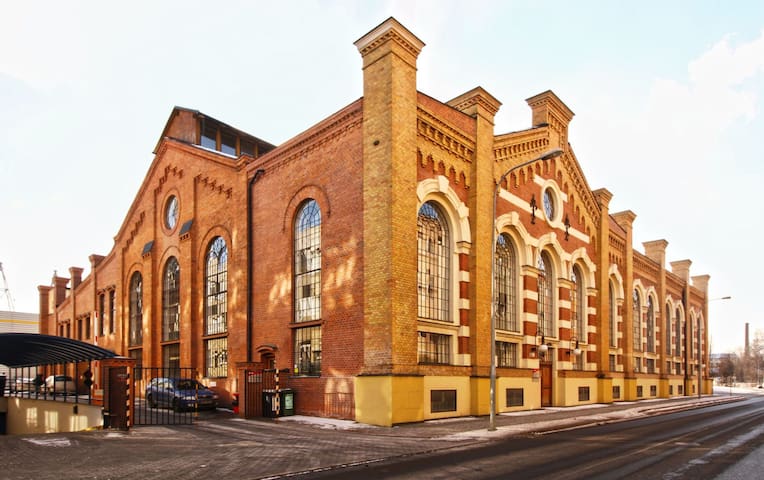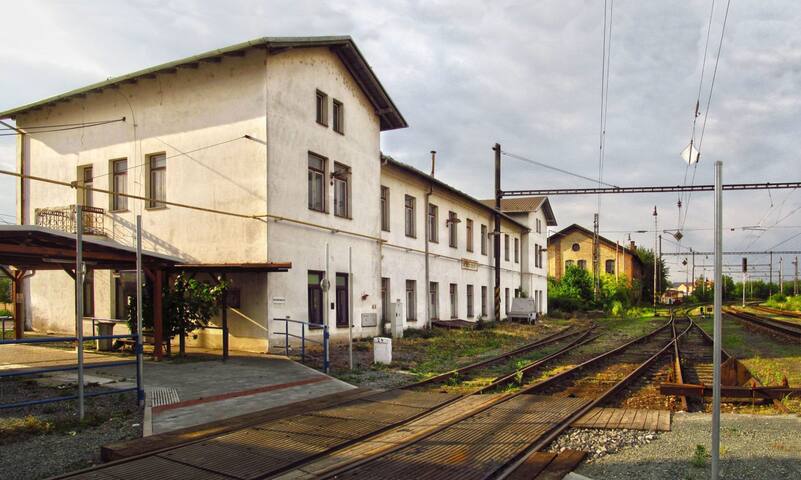Brno's Technical Monuments
As the second largest Czech city and an important industrial centre in the 19th and 20th centuries, Brno has a lot to offer lovers of technical monuments.
Especially the city’s east side and both banks of the Svitava still host engineering companies with long traditions and grounds that are interesting sights in themselves – První brněnská strojírna, Zetor, Šmeral, Alstom, Siemens, and Královopolská strojírna to the north. Other spectacular industrial companies can still be seen even though their time has passed – we can recall the Kras complex of clothing factories, Zbrojovka in Židenice, and the more modern Lachema in Řečkovice.
What really turned Brno into a city was its textile industry. From the end of the 18th century, factories sprung up especially in the Brno suburbs of Horní and Dolní Cejl and later transformed into modern carding, spinning, weaving, and dyeing mills, the production of which was known throughout the world and gave Brno the nickname of the Moravian Manchester. Although the Brno textile tradition became history at the turn of the millennium, industry in the city has continued to develop in the modern spirit.
Let us here turn back to monuments to the famous period of the 19th and 20th centuries that have been left in the city over the past 200 years.
It is especially worth mentioning the dozens of scattered buildings of former textile mills; factory grounds; under- and above-ground canals, often older than the city itself; the complicated development of railway junctions; gasworks; power stations including the dam at the reservoir near the city; and the history of public transit, brewing, the soaring buildings at and around the exhibition centre, and many other places connected to industry, transit, and energy.
TEXTILE SUBURB OF CEJL
With the arrival of the Industrial Revolution, this originally suburban settlement with the German name Zeile (row) became a factory outpost of Brno.
Dozens of textile factories sprung up on both sides of Dolní Cejl among the historic city, the Svitava River, and the Svitava Canal, the later two of which supplied water to the factories for practically the entire 19th century. Thousands of workers coming for work to Brno from surrounding towns changed the face of the city, and the factories turned Brno into the Moravian Manchester – an industrial city and the centre of Moravia.
Although most of the textile factories have ben turned into flats and offices, you can still find on Cejl about 20 palaces of industry, the remains of textile operations and gallery buildings that housed thousands of workers in appalling conditions. The most interesting palaces include the palace of the Schoeller brothers, Hechtův palace, and the spinning mill of the Soxhlet brothers.
Bratislavská 265/71
71 BratislavskáTEXTILE SUBURB OF CEJL
With the arrival of the Industrial Revolution, this originally suburban settlement with the German name Zeile (row) became a factory outpost of Brno.
Dozens of textile factories sprung up on both sides of Dolní Cejl among the historic city, the Svitava River, and the Svitava Canal, the later two of which supplied water to the factories for practically the entire 19th century. Thousands of workers coming for work to Brno from surrounding towns changed the face of the city, and the factories turned Brno into the Moravian Manchester – an industrial city and the centre of Moravia.
Although most of the textile factories have ben turned into flats and offices, you can still find on Cejl about 20 palaces of industry, the remains of textile operations and gallery buildings that housed thousands of workers in appalling conditions. The most interesting palaces include the palace of the Schoeller brothers, Hechtův palace, and the spinning mill of the Soxhlet brothers.
ESSLER SPINNING MILL
In the location of the original mill on an island in the Svitava in Obřany stands the gloomy building of the Essler Spinning Mill.
This factory was built in 1912 in place of an older, single-storey mill by Ernst Essler, and at the time it was built it was the only factory in Brno made only from reinforced concrete. The spinning mill and connected weaving mill processed various plant materials and wool to make textile yarn, which was distributed to other Brno mills. In 1945, production was taken over by the national enterprise Mosilana, but continued in the building until 1992.
Currently, the building is being considered for renovations. You can see the dilapidated building from a bridge over the Svitava, built unusually wide for a planned tram track, or from the train on the railway viaduct over the spinning mill.
Fryčajova
FryčajovaESSLER SPINNING MILL
In the location of the original mill on an island in the Svitava in Obřany stands the gloomy building of the Essler Spinning Mill.
This factory was built in 1912 in place of an older, single-storey mill by Ernst Essler, and at the time it was built it was the only factory in Brno made only from reinforced concrete. The spinning mill and connected weaving mill processed various plant materials and wool to make textile yarn, which was distributed to other Brno mills. In 1945, production was taken over by the national enterprise Mosilana, but continued in the building until 1992.
Currently, the building is being considered for renovations. You can see the dilapidated building from a bridge over the Svitava, built unusually wide for a planned tram track, or from the train on the railway viaduct over the spinning mill.
VLNĚNA AND MOSILANA
In the 1950s, all Brno textile mills were gradually nationalized and closed down or incorporated into one of two national enterprises, Vlněna or Mosilana.
The consolidation of previously competing and isolated businesses led to the creation of an interesting factory complex with an unusual structure over the Svitava Canal. While almost all of the Vlněna buildings among Přízova, Mlýnská, and Dornych streets were knocked down in 2016 (the Nová Vlněna campus arose in their place), the Mosilana grounds among Křenová, Vlhká, and Cejl streets is accessible during the day with the porter’s permission and still offers a unique industrial experience. Modern companies currently operate in the maze of production buildings in the location of the former Sdružené továrny vlněného zboží, Hecht weaving mill, and company of Max Kohn and Gustav Schiketanz, pioneers in the Brno textile industry.
19, Křenová 89
19 KřenováVLNĚNA AND MOSILANA
In the 1950s, all Brno textile mills were gradually nationalized and closed down or incorporated into one of two national enterprises, Vlněna or Mosilana.
The consolidation of previously competing and isolated businesses led to the creation of an interesting factory complex with an unusual structure over the Svitava Canal. While almost all of the Vlněna buildings among Přízova, Mlýnská, and Dornych streets were knocked down in 2016 (the Nová Vlněna campus arose in their place), the Mosilana grounds among Křenová, Vlhká, and Cejl streets is accessible during the day with the porter’s permission and still offers a unique industrial experience. Modern companies currently operate in the maze of production buildings in the location of the former Sdružené továrny vlněného zboží, Hecht weaving mill, and company of Max Kohn and Gustav Schiketanz, pioneers in the Brno textile industry.
WANNIECK MACHINE FACTORY
Closely following textile production, the machine industry came to Brno, first to make textile machines and their parts and later expanding to a wide range of other devices.
In 1865 between the contemporary upper and lower railway stations, the Wannieck machine factory was founded and began making equipment for sugar refineries and then steam engines licensed by the Swiss company Sulzer. After consolidation with První brněnská strojírna in the 1930s, the grounds transferred to Česká zbrojovka and production started on steam turbines licensed by the British company Parsons.
After World War II, Vaňkovka became part of Zetor, and it remained so until 1996. After being shut down, the factory got lucky – instead of being demolished its most interesting building was preserved as part of a shopping centre and gallery that are still open to the public.
Ve Vaňkovce 465/2
2 Ve VaňkovceWANNIECK MACHINE FACTORY
Closely following textile production, the machine industry came to Brno, first to make textile machines and their parts and later expanding to a wide range of other devices.
In 1865 between the contemporary upper and lower railway stations, the Wannieck machine factory was founded and began making equipment for sugar refineries and then steam engines licensed by the Swiss company Sulzer. After consolidation with První brněnská strojírna in the 1930s, the grounds transferred to Česká zbrojovka and production started on steam turbines licensed by the British company Parsons.
After World War II, Vaňkovka became part of Zetor, and it remained so until 1996. After being shut down, the factory got lucky – instead of being demolished its most interesting building was preserved as part of a shopping centre and gallery that are still open to the public.
FIRST BRNO POWER STATION
Brno’s Mahenovo divadlo (Mahen Theatre) was the first building of its type in the world to be lit by electric light.
Installation of the lighting based on plans by Thomas Edison in 1882 required 1,920 lightbulbs with carbon filaments, 5 arc lamps, an electric fan above the stage, and a steam power station to supply electricity to the theatre. While the theatre was built on the road circling the city centre in place of the demolished city wall, the power station with seven generators with an output of 81 kW was concealed a ways off on the edge of the industrial area of Dolní Cejl.
The power station also served several Brno streets and direct current flowed from it into the city until 1898. The station building was damaged during bombing in World War II, but part of it still remains and currently serves as the theatre’s joinery workshop.
Vlhká 161/5
5 VlhkáFIRST BRNO POWER STATION
Brno’s Mahenovo divadlo (Mahen Theatre) was the first building of its type in the world to be lit by electric light.
Installation of the lighting based on plans by Thomas Edison in 1882 required 1,920 lightbulbs with carbon filaments, 5 arc lamps, an electric fan above the stage, and a steam power station to supply electricity to the theatre. While the theatre was built on the road circling the city centre in place of the demolished city wall, the power station with seven generators with an output of 81 kW was concealed a ways off on the edge of the industrial area of Dolní Cejl.
The power station also served several Brno streets and direct current flowed from it into the city until 1898. The station building was damaged during bombing in World War II, but part of it still remains and currently serves as the theatre’s joinery workshop.
SECOND BRNO POWER STATION
The city’s second steam power station was only in operation for 14 years and led Brno on its journey from steam power to the age of electricity.
This power station built in 1898 within a gasworks on Radlas street underwent constant expansion throughout its operation. It had an original output of 600 kW of modern alternating current, while several generators built from 1900 also sent direct current to the city’s new tram lines. The elegant building functioned until 1912, when electricity began being sent to Brno from a modern thermal power station in Oslavany. A motor generator was then added to the building to regulate the electricity from Oslavany for the tram line. The power station has undergone renovations and now serves as an office building.
Plynárenská 30
SECOND BRNO POWER STATION
The city’s second steam power station was only in operation for 14 years and led Brno on its journey from steam power to the age of electricity.
This power station built in 1898 within a gasworks on Radlas street underwent constant expansion throughout its operation. It had an original output of 600 kW of modern alternating current, while several generators built from 1900 also sent direct current to the city’s new tram lines. The elegant building functioned until 1912, when electricity began being sent to Brno from a modern thermal power station in Oslavany. A motor generator was then added to the building to regulate the electricity from Oslavany for the tram line. The power station has undergone renovations and now serves as an office building.
MUNICIPAL SLAUGHTERHOUSE STARCH FACTORY AND MEAT MARKET
This collection of historicist buildings from 1895–1909 comprising a slaughterhouse, meat market, and stable on the bank of the Svitava gives off a romantic fairy tale-like impression.
Vaulted halls with bricks in two colours complement the impressive, decorated top of the unused water tower. Livestock vehicles used to be pulled by steam locomotives along tram lines down Křenová street to Masná street, and the whole area was closed off and guarded. In contrast, the neighbouring starch factory has undergone sensitive renovations and now offers a pleasant retreat consistent with the entirely industrial history of this former factory area.
On Masná street between the former starch factory and slaughterhouse stands the functionalist meat market from 1924 designed by Bohuslav Fuchs. The starch factory and slaughterhouse are used for administration and production, including a microbrewery open to the public.
Masná 180/7
7 MasnáMUNICIPAL SLAUGHTERHOUSE STARCH FACTORY AND MEAT MARKET
This collection of historicist buildings from 1895–1909 comprising a slaughterhouse, meat market, and stable on the bank of the Svitava gives off a romantic fairy tale-like impression.
Vaulted halls with bricks in two colours complement the impressive, decorated top of the unused water tower. Livestock vehicles used to be pulled by steam locomotives along tram lines down Křenová street to Masná street, and the whole area was closed off and guarded. In contrast, the neighbouring starch factory has undergone sensitive renovations and now offers a pleasant retreat consistent with the entirely industrial history of this former factory area.
On Masná street between the former starch factory and slaughterhouse stands the functionalist meat market from 1924 designed by Bohuslav Fuchs. The starch factory and slaughterhouse are used for administration and production, including a microbrewery open to the public.
BRNO RAILWAY STATIONS
Some railway stations are not in the timetable even though they receive daily stops from trains, usually carrying freight.
In addition to dozens of closed Brno stops and stations (a preserved building in Zábrdovice, the railway yard at the old station in Královo Pole, stops and buildings in Husovice, Lískovec, Jehnice, Holásky, and Ivanovice), it is worth visiting Dolní nádraží (Lower Railway Station) not far from the Brno centre, used throughout 2019 for diverted passenger traffic.
Those interested in Brno railways will also enjoy a visit to the forgotten Brno-jih station far from the city or the lookout over the shunting yard in Maloměřice. From the footbridges above the yard, one of the largest Czech railway stations looks like a model – practically every day small and large fans of railways watch the automatic sorting of wagons to humps.
Rosická 1
1 RosickáBRNO RAILWAY STATIONS
Some railway stations are not in the timetable even though they receive daily stops from trains, usually carrying freight.
In addition to dozens of closed Brno stops and stations (a preserved building in Zábrdovice, the railway yard at the old station in Královo Pole, stops and buildings in Husovice, Lískovec, Jehnice, Holásky, and Ivanovice), it is worth visiting Dolní nádraží (Lower Railway Station) not far from the Brno centre, used throughout 2019 for diverted passenger traffic.
Those interested in Brno railways will also enjoy a visit to the forgotten Brno-jih station far from the city or the lookout over the shunting yard in Maloměřice. From the footbridges above the yard, one of the largest Czech railway stations looks like a model – practically every day small and large fans of railways watch the automatic sorting of wagons to humps.
SVITAVA CANAL
Every resident of Brno must know some of the legends about Ponávka. It dips into the ground and shoots back up somewhere among the factories on Cejl, and no one knows exactly where it runs from or to.
Brno used to be interwoven with many strands from the Svratka, Svitava, and Ponávka, with the water powering many mills. All that remains today is the winding Svitava Canal. While since 1993 the Ponávka itself has run through a tunnel from Královo Pole under Lesná to the Cacovický Canal, on Radlas, Špitálka, Vlhká, and Škrobárenská streets you can still walk over bridges and the remains of banks that once formed the most romantic part of the city.
After being shortened, the Svitava Canal runs 3.6 km, of which almost 1 km runs through underground tunnels, and it joins the Svratka under the bicycle path by Jeneweinova street.
Ponávka
PonávkaSVITAVA CANAL
Every resident of Brno must know some of the legends about Ponávka. It dips into the ground and shoots back up somewhere among the factories on Cejl, and no one knows exactly where it runs from or to.
Brno used to be interwoven with many strands from the Svratka, Svitava, and Ponávka, with the water powering many mills. All that remains today is the winding Svitava Canal. While since 1993 the Ponávka itself has run through a tunnel from Královo Pole under Lesná to the Cacovický Canal, on Radlas, Špitálka, Vlhká, and Škrobárenská streets you can still walk over bridges and the remains of banks that once formed the most romantic part of the city.
After being shortened, the Svitava Canal runs 3.6 km, of which almost 1 km runs through underground tunnels, and it joins the Svratka under the bicycle path by Jeneweinova street.
BRNO BRIDGES AND FOOTBRIDGES
Over rivers, roads, valleys, and railway tracks in Brno run dozens of bridges for cars, trains, and pedestrians. This is a selection of the five most interesting Brno bridges:
Tram bridge over the Brno Exhibition Centre (1965) – an elegant, asymmetric bridge bent in every direction
Railway arch viaduct in Obřany (1952) – this stone arch bridge was originally to be decorated with statues
Footbridge over the reservoir (2003) – built under Veveří Castle in place of a bridge destroyed in 1945 by the German Army
Arched tram bridge in Maloměřice (1928) – a reinforced concrete bridge that was the only bridge in Brno to survive World War II
Footbridge over Maloměřice railway station (1981) – a four-km footbridge offering a view of the shunting yard from a height of 12 m
Maloměřice
BRNO BRIDGES AND FOOTBRIDGES
Over rivers, roads, valleys, and railway tracks in Brno run dozens of bridges for cars, trains, and pedestrians. This is a selection of the five most interesting Brno bridges:
Tram bridge over the Brno Exhibition Centre (1965) – an elegant, asymmetric bridge bent in every direction
Railway arch viaduct in Obřany (1952) – this stone arch bridge was originally to be decorated with statues
Footbridge over the reservoir (2003) – built under Veveří Castle in place of a bridge destroyed in 1945 by the German Army
Arched tram bridge in Maloměřice (1928) – a reinforced concrete bridge that was the only bridge in Brno to survive World War II
Footbridge over Maloměřice railway station (1981) – a four-km footbridge offering a view of the shunting yard from a height of 12 m



